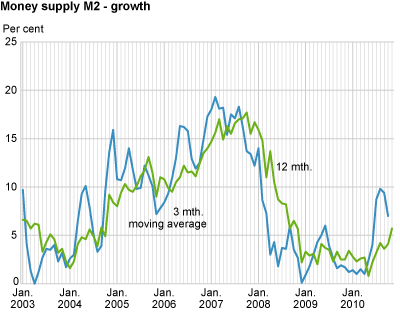Content
Published:
This is an archived release.
Sharp increase in money supply growth
The twelve-month growth in total money supply (M2) was 5.7 per cent to end-November. This is an increase from 4.1 per cent to end-October, and the highest twelve-month growth since November 2008.
The total money supply amounted to NOK 1 596 billion by end-November, up from NOK 1 588 billion by end-October. The money supply is the highest ever recorded.
Strong increase in growth for non-financial enterprises, decrease for other financial enterprises
Non-financial enterprise money supply amounted to NOK 534 billion at end-November and the twelve-month growth was 5.3 per cent. The twelve-month growth has not been higher since May 2008. By comparison, the non-financial money supply amounted to NOK 522 billion at end-October and the twelve-month growth was 1.4 per cent. Non-financial enterprise money supply constituted 44 per cent of their gross domestic debt measured by the credit indicator C2 at end-November, unaltered from the previous month.
Other financial enterprise money supply amounted to NOK 143 billion at end-November, up from NOK 138 billion at end-October. The twelve-month growth was 3.9 per cent to end-November, down from 5.3 per cent to the previous month. Other financial enterprises were the only sector with a decrease in the twelve-month growth at end-November.
Sharp increase in municipal government money supply growth
Municipal government money supply amounted to a modest NOK 63 billion at end-November. The twelve-month growth was at the same time 17.5 per cent, an increase from 10.8 per cent at end-October and the highest growth measured since September 2007.
Rise also in household money supply growth
Households’ money supply amounted to NOK 855 billion by end-November, down from NOK 864 billion to the previous month. This constituted more than half of the total money supply. The twelve-month growth in households’ money supply was 5.6 per cent to end-November, up from 5.2 per cent to end-October. This is the highest twelve-month growth measured for households since October 2009. The growth in households’ money supply was lower than the growth in households’ gross domestic debt, which was 6.4 per cent to end-November, according to the credit indicator C2 . For more information on the financial position of households, see the financial accounts in the national accounts .
| June 2010 | July 2010 | Aug. 2010 | Sep. 2010 | Oct. 2010 | Nov. 2010 | ||||||||||||||||||||||||||||||||||||||||||||||||||||||||||||||||||||||||||
|---|---|---|---|---|---|---|---|---|---|---|---|---|---|---|---|---|---|---|---|---|---|---|---|---|---|---|---|---|---|---|---|---|---|---|---|---|---|---|---|---|---|---|---|---|---|---|---|---|---|---|---|---|---|---|---|---|---|---|---|---|---|---|---|---|---|---|---|---|---|---|---|---|---|---|---|---|---|---|---|
| M0 - 12 mth. | -31.2 | -31.3 | -5.7 | 1.0 | -26.6 | 11.9 | |||||||||||||||||||||||||||||||||||||||||||||||||||||||||||||||||||||||||
| M1 - 12 mth. | 0.3 | 1.6 | 2.2 | 2.0 | 2.5 | 5.1 | |||||||||||||||||||||||||||||||||||||||||||||||||||||||||||||||||||||||||
| M2 - 12 mth. | 2.2 | 3.2 | 4.2 | 3.6 | 4.1 | 5.7 | |||||||||||||||||||||||||||||||||||||||||||||||||||||||||||||||||||||||||
| M2 - 3 mth. moving average | 4.0 | 8.7 | 9.8 | 9.4 | 7.0 | ||||||||||||||||||||||||||||||||||||||||||||||||||||||||||||||||||||||||||
| M2 households - 12 mth. | 3.8 | 4.4 | 4.1 | 4.6 | 5.2 | 5.6 | |||||||||||||||||||||||||||||||||||||||||||||||||||||||||||||||||||||||||
| M2 non-financial enterprises - 12 mth. | -2.9 | -1.6 | 1.1 | 0.8 | 1.4 | 5.3 | |||||||||||||||||||||||||||||||||||||||||||||||||||||||||||||||||||||||||
Base money increase again
Base money amounted to NOK 93 billion at end-November, up from NOK 84 billion to the previous month. The twelve-month growth in M0 was 11.9 per cent, up from -26.6 per cent to end-October. The increase is mainly caused by an increase of bank deposits in Norges Bank during November, but notes and coins in circulation also contributed to the increase.
|
The money supply (broad monetary aggregate) M2 consists of notes and coins, unrestricted bank deposits, certificates of deposit and units in money market funds owned by the money-holding sector, i.e. households, non-financial enterprises, municipalities and financial enterprises other than state lending institutions, banks and money market funds.
The base money (M0) is defined as banks’ and the money-holding sector's notes and coins and deposits in Norges Bank. Banks’ deposits in Norges Bank comprise current account (sight) deposits and fixed rate (time) deposits (F-deposits), from Norges Bank’s monthly balance sheet.
Other financial enterprises include financial enterprises other than lending institutions, banks and money market funds. |
|
Growth based on the three-month moving average is defined as growth in average money supply (seasonally-adjusted figures) in the latest three-month period in relation to the previous three-month period. The growth is adjusted for exchange rate valuation changes and statistical breaks as an annualised figure. The calculation is centred; in other words, the observation is set at the middle month of the latest three-month period. |
Tables
The statistics is published with Monetary aggregates.
Contact
-
Statistics Norway's Information Centre
E-mail: informasjon@ssb.no
tel.: (+47) 21 09 46 42

